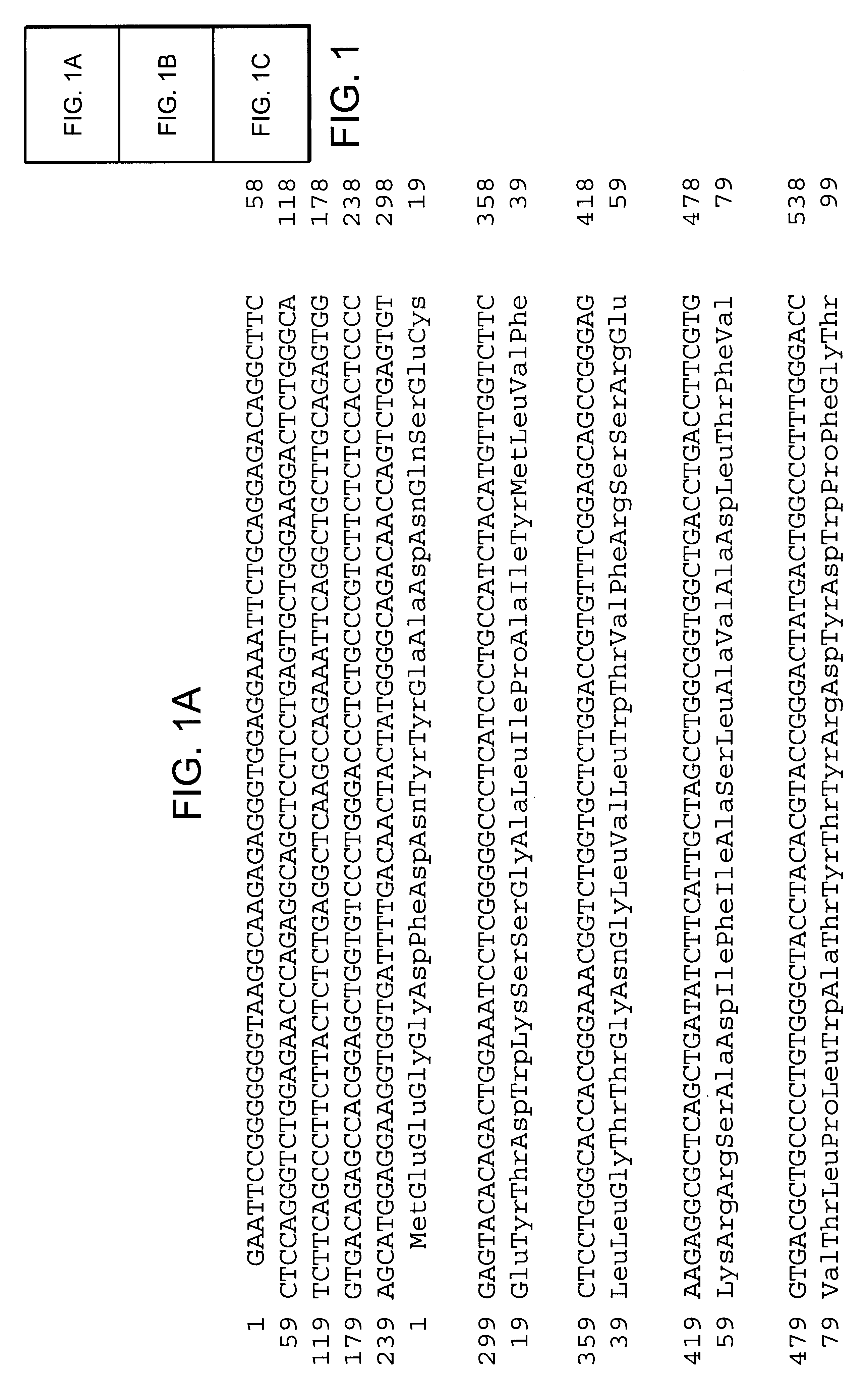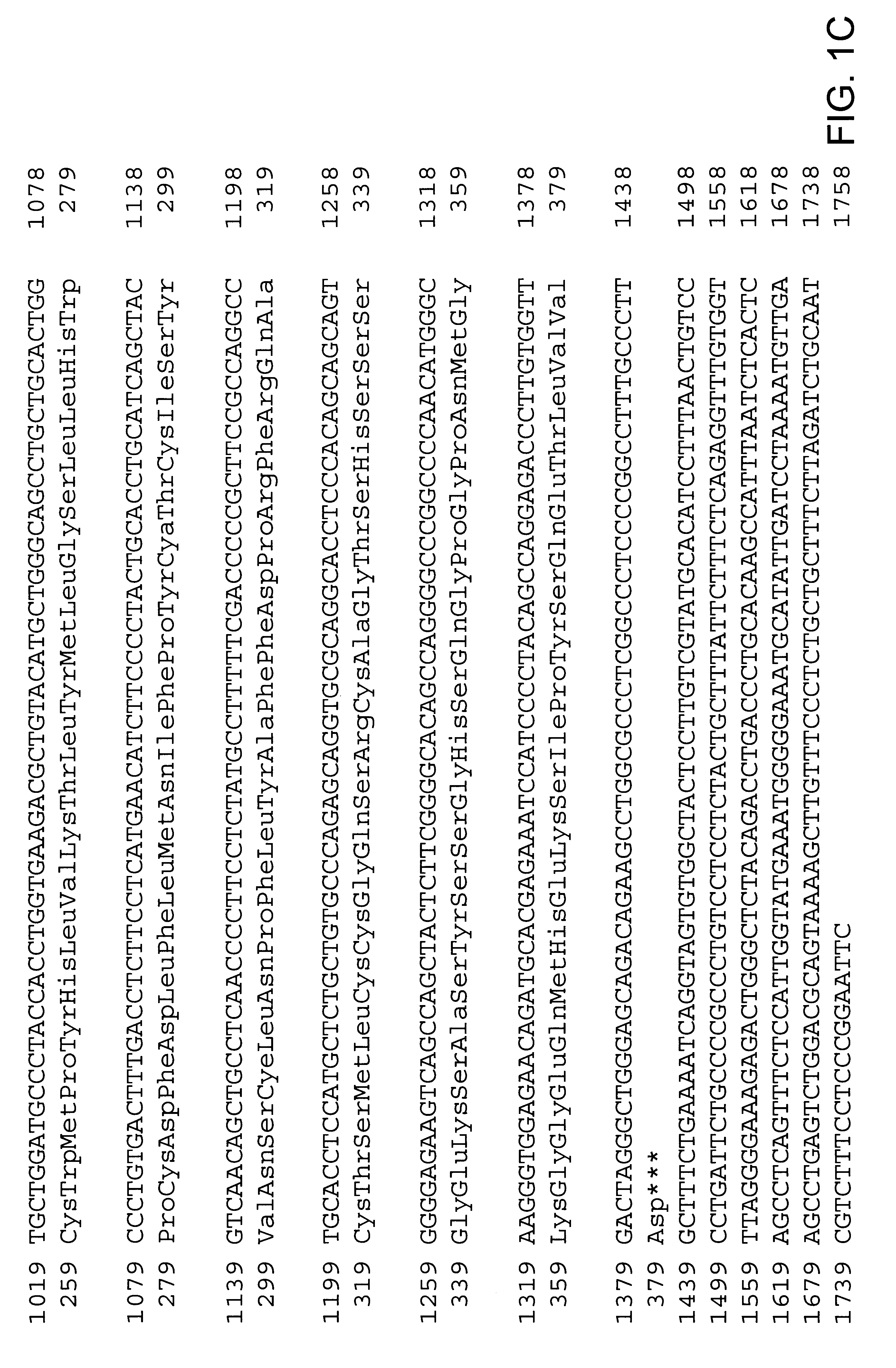APJ ligand polypeptides
a technology of ligands and polypeptides, applied in the field of apj ligand polypeptides, can solve the problems of difficult to predict the ligand ligand, the structure and function of the ligand have not been elucidated, and the difficulty in estimating the ligand based on the similarity in primary structure alon
- Summary
- Abstract
- Description
- Claims
- Application Information
AI Technical Summary
Benefits of technology
Problems solved by technology
Method used
Image
Examples
reference example 1
Production of Synthetic DNA Primers for Amplifying a DNA Coding for the G Protein-coupled Receptor Protein
The nucleotide sequences of the cDNAs respectively coding for amino acid sequences in the vicinity of the first transmembrane domain of known human-derived TRH receptor protein (HTRHR), human-derived RANTES receptor protein (L10918, HUMRANTES), human Burkitt's lymphoma-derived unknown-ligand receptor protein (X68149, HSBLRIA), human-derived somatostatin receptor protein (L14856, HUMSOMAT), rat-derived .mu.-opioid receptor protein (U02083, RNU02083), rat-derived .kappa.-opioid receptor protein (U00442, U00442), human-derived neuromedin B receptor protein (M73482, HUMNMBR), human-derived muscarinergic acetylcholine receptor protein (X15266, HSHM4), rat-derived adrenaline .alpha. 1B receptor protein (L08609, RATAADRE01), human-derived somatostatin 3 receptor protein (M96738, HUMSSTR3X), human-derived C5a receptor protein (HUMC5AAR), human-derived unknown-ligand receptor protein (HU...
example 2
Cloning of a cDNA Containing the Full-length Coding Region of the Receptor Protein from a Human Amygdala-derived cDNA Library
For obtaining a DNA coding for the full-length APJ receptor, a human amygdala-derived cDNA library was screened using the APJ receptor cDNA fragment obtained in Example 1 as a probe. The human amygdala-derived cDNA library used was Clontech's library (Clontech, CLHL30086) in which the .lambda. gt11 phage vector is used. An amount of the human amygdala cDNA library corresponding to 2.times.10.sup.6 pfu (plaque-forming units) was admixed with magnesium sulfate-treated Escherichia coli Y1090. After 15 minutes of incubation at 37.degree. C., 0.5% agarose (Pharmacia) LB was added, and 1.5% agar (Wako Pure Chemical) LB plates (containing 50 .mu.g / ml ampicillin) were seeded with the resulting mixture. After overnight culture at 42.degree. C., a nitrocellulose filter was placed on each plate with plaques formed thereon, for plaque transfer onto the filter. This filter...
example 3
Detection, by Northern Hybridization, of Expression and Distribution of the APJ Receptor mRNA in Human Tissues
For detecting the expression, on the mRNA level, of APJ encoded by the plasmid pUC118-.lambda.34 obtained in Example 2 in human tissues, Northern blotting was carried out. The filters used for Northern blot were Human MTN Blot I and II (CL7760-1, CL7759-1), and the probe used was the same one as used in Example 1. Hybridization was effected by incubating the above-mentioned filters and probe overnight at 42.degree. C. in a buffer containing 50% formamide, 5.times.SSPE, 10.times.Denhardt's solution, 2% SDS and 100 .mu.g / ml salmon sperm DNA. The filters were washed with 0.1.times.SSC plus 0.1% SDS at 50.degree. C. and, after air drying, X ray films (XAR5, Kodak) were exposed thereto at -80.degree. C. for 3 days. The results are shown in FIG. 2. From FIG. 2, it was revealed that the receptor gene encoded by pUC118-A 34 is expressed in human heart, brain, placenta, liver, skelet...
PUM
| Property | Measurement | Unit |
|---|---|---|
| Temperature | aaaaa | aaaaa |
| Temperature | aaaaa | aaaaa |
| Fraction | aaaaa | aaaaa |
Abstract
Description
Claims
Application Information
 Login to View More
Login to View More - R&D
- Intellectual Property
- Life Sciences
- Materials
- Tech Scout
- Unparalleled Data Quality
- Higher Quality Content
- 60% Fewer Hallucinations
Browse by: Latest US Patents, China's latest patents, Technical Efficacy Thesaurus, Application Domain, Technology Topic, Popular Technical Reports.
© 2025 PatSnap. All rights reserved.Legal|Privacy policy|Modern Slavery Act Transparency Statement|Sitemap|About US| Contact US: help@patsnap.com



